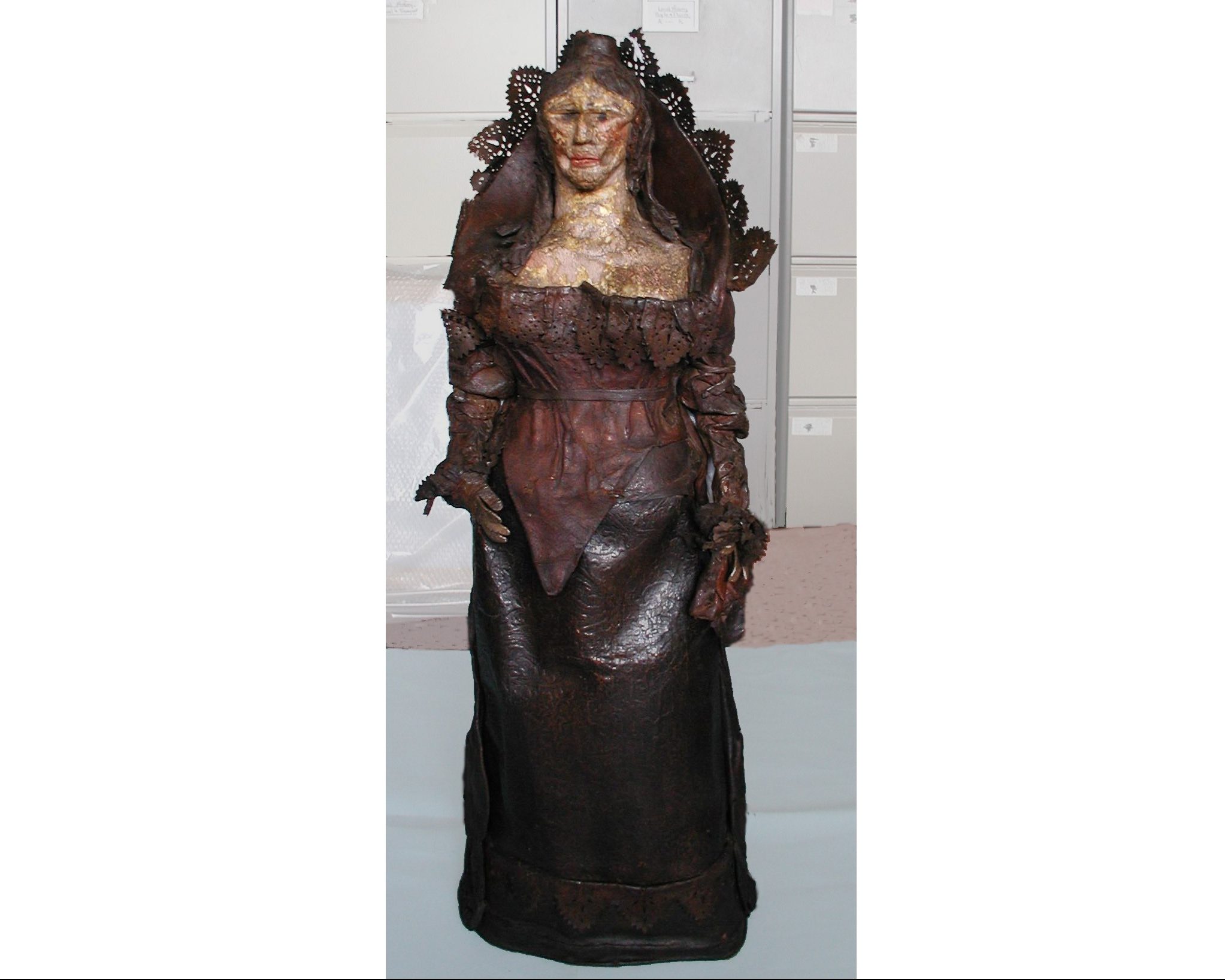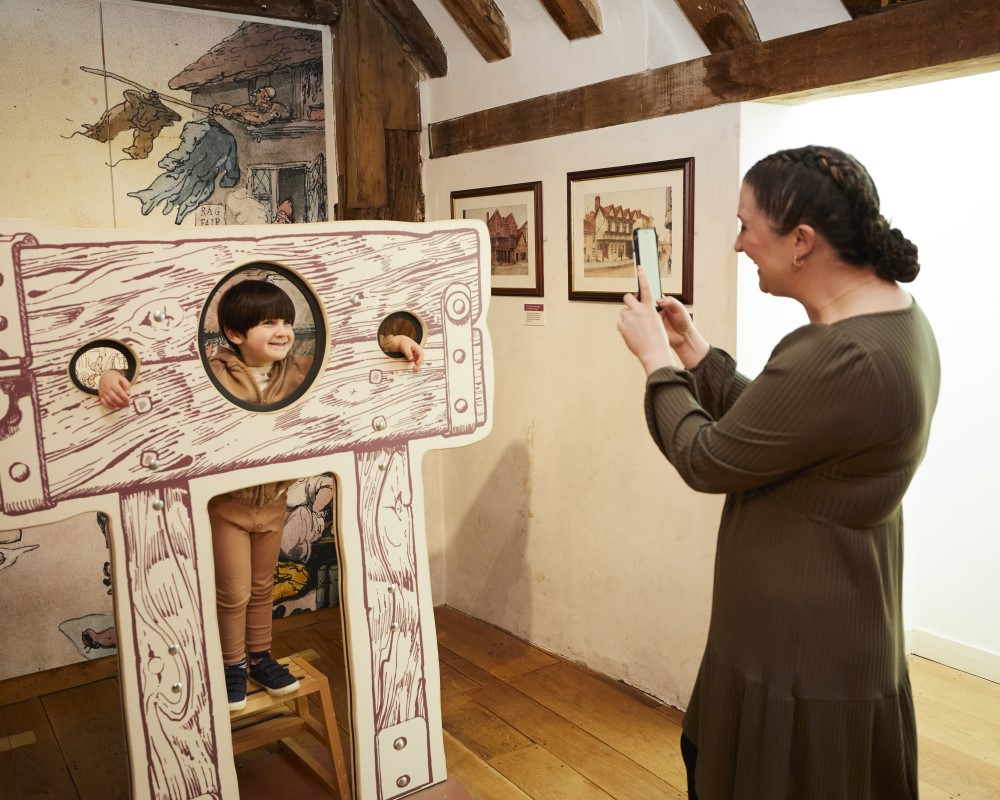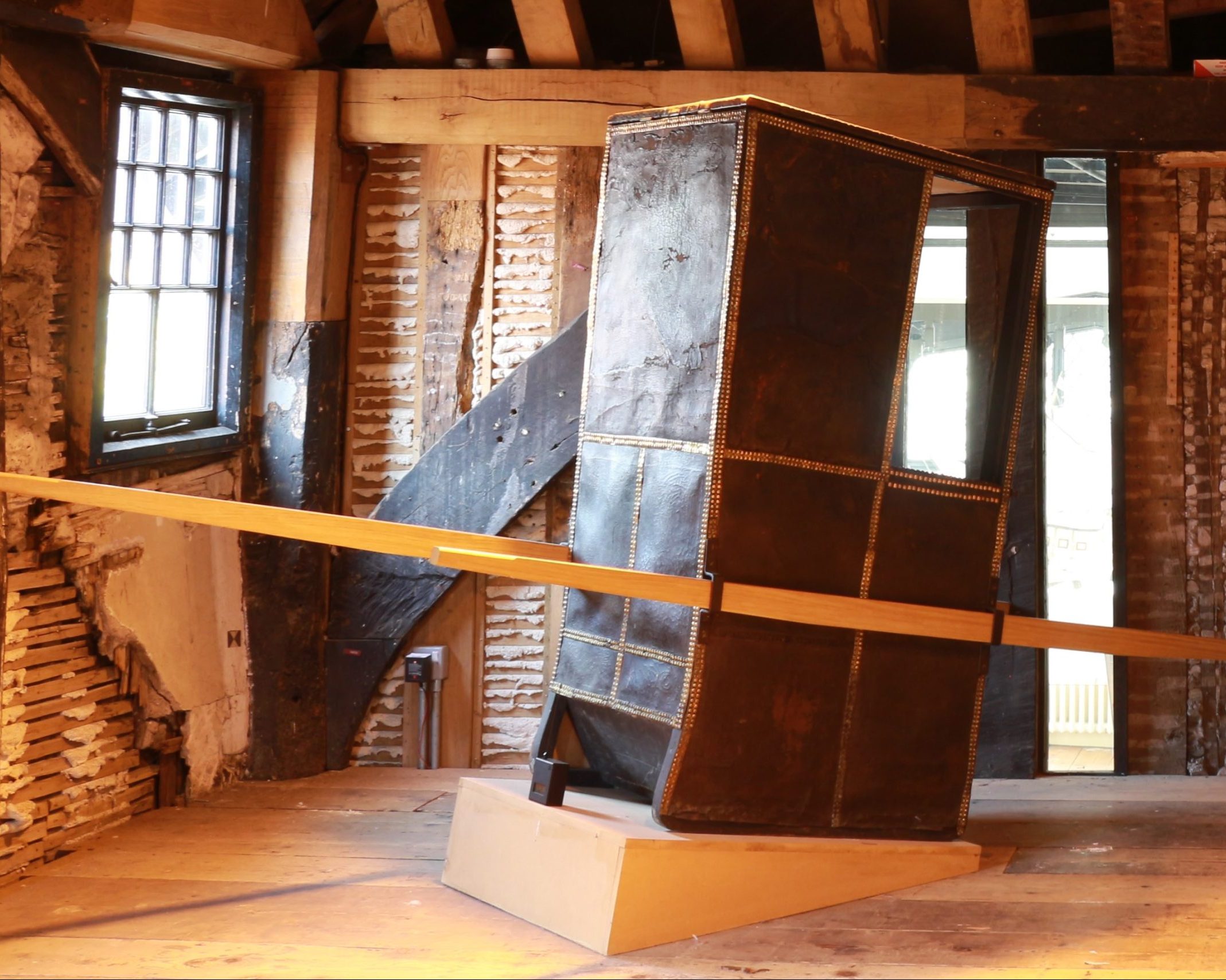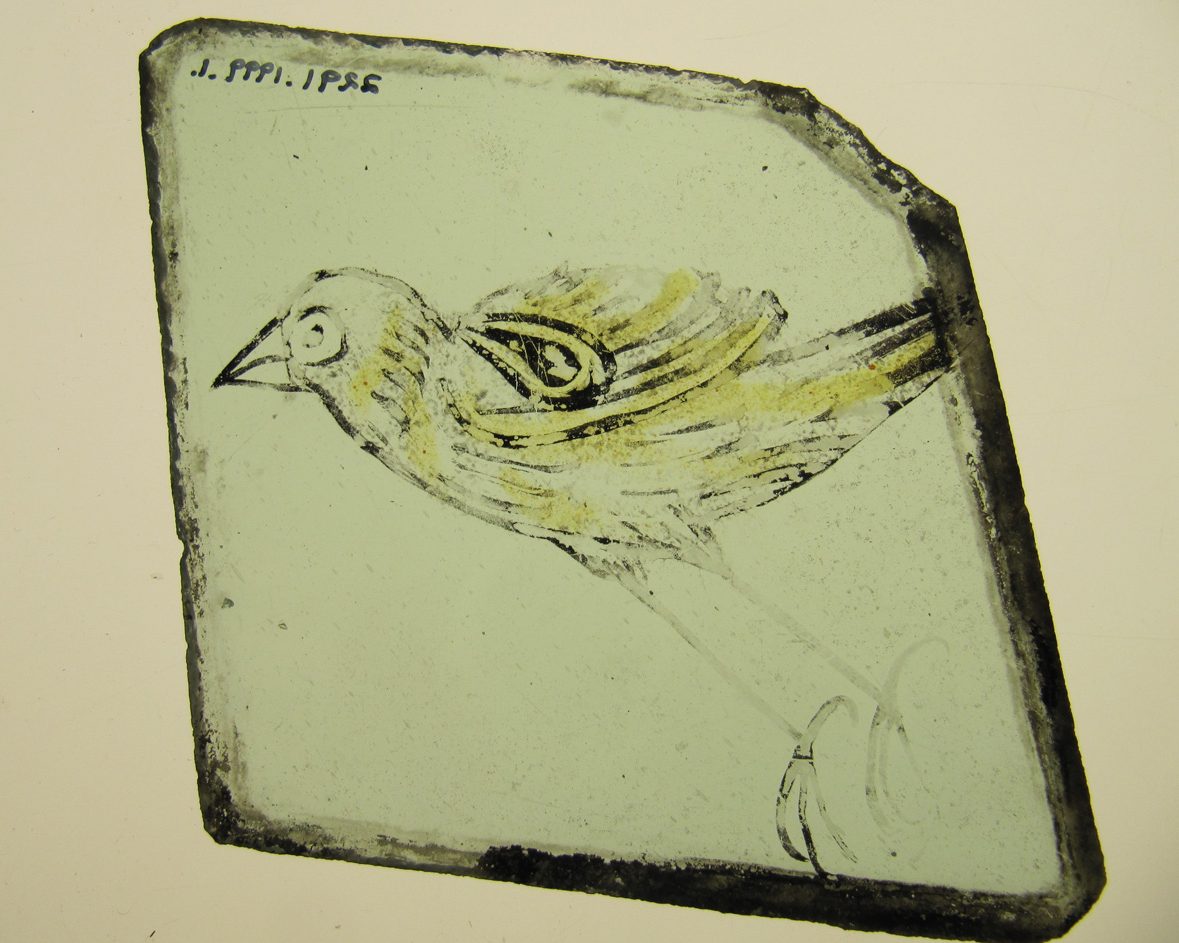Skip to content

The jug has been restored painstakingly and sensitively to retain its patina and original character and can be found in the Banqueting Hall. It is essential that we keep it in humidity-controlled conditions as leather – especially old leather – is very sensitive to changes in humidity, which could cause irreparable damage. We also have to protect it from direct sunlight and sources of heat.

Built of wood or metal, stocks held the ankles in place so that the prisoner sat with their legs outstretched, unable to move and preventing the blood from circulating which would have been uncomfortable to say the least. Extra chains and weights were sometimes used to make the punishment even more uncomfortable whilst passers-by would add to the humiliation by throwing rotten fruits and vegetables at the unfortunate offender. Although not the intended goal of a spell in the stocks, occasionally prisoners would die whilst held in them, particularly from exposure to the elements if left in them for too long a period.
The stocks at Tudor House would have been used to punish offenders for minor crimes and disturbances of the peace such as public drunkenness, fighting, vagrancy and trespass. Each parish in Southampton, such as All Saints, Above Bar, St Michael’s, Holy Rood and St Mary’s would have been entitled to its own set of stocks, although their exact locations remain unknown.

The Book of Hours is a personal prayer book, dating to the late 15th century. It was consulted during the day to help the owner carry out her daily devotions. It is written in Flemish, with some Latin, and was probably made in the Netherlands around 1480.
These books tended to contain the same core elements, although no two are exactly the same. Our book contains a descriptive and illustrated calendar of the fixed festivals of the Christian church with descriptions and illustrations of medieval people carrying out their occupations and leisure pursuits of particular months. It also contains the Hours of the Virgin – rules for the recital of certain prayers at specific times of the day – and the Office of the Dead, a collection of psalms and readings intended to be said around the coffin of a deceased person.

Unlike the present day when most graffiti is considered a form of vandalism, in earlier centuries the drawing of graffiti was widely tolerated and is found in many historic buildings. It was usually small-scale, scratched or marked on a surface, and most of the individuals who created it were not trained artists but ordinary people, doodling or sometimes making detailed drawings that represented aspect of their lives.
Tudor House and Garden stands close the former waterfront of Tudor and Stuart Southampton, and belonged to ship owners in the late 1500s and early 1600s, when the town was a base for privateers and pirates. The graffiti in the room includes many different kinds of images of ships and people, caricatures of people in authority, sketches of animals and symbols and other shapes. The types of ships and costume enable us to date them with reasonable accuracy. Many of the images are probably the work of sailors, and reflect the daily reality of life as lived by people 400 years ago.

Penny farthing bicycles were invented in 1871 by British engineer James Starley and enjoyed brief popularity in both the UK and US for around 20 years. They were also known as ‘high’ or ‘ordinary’ bicycles. They had a small rear wheel and large front wheel pivoting on a simple tubular frame, with solid rubber tyres. They were named after the two British coins, the penny and farthing.
They were soon overtaken in popularity by ‘road safety bicycles’, launched in 1885. Their small-scale chain drives meant that the same speed could be achieved without the need for the large wheel, and the rider could sit more safely, much lower down, which also made dismounting much easier.

Two men called ‘chairmen’ would carry the Sedan Chair, one at the front and the other at the back, by holding wooden poles, one on each side of the chair inserted into brackets.
Wealthy families could own their own chairs which would have been elaborately decorated with silk upholstery, often with curtains at the windows which provided privacy for the traveller.
The Sedan Chair at Tudor House was a public Sedan Chair for hire indicated by the number painted on the back of the chair. The side windows and door at the front were originally glazed and the roof was hinged to allow easier access.
People could hire this chair during the day and going anywhere within the city’s limits would cost 6d., but at night the fee would double. As well as having the chairmen carry the chair, at night there would be an additional two ‘links boys’ ahead of the chair holding gas lamps, lighting the way.
This Sedan Chair has been restored at the Leather Conservation Centre in Northampton; it was during this work that conservators discovered the number painted on the back indicating that it was chair for public use.

The first recognisable hot cross bun was made in 1361 by a monk named Brother Thomas Rocliffe. The Alban Bun, as it was known, had a cross cut into the top of the bun rather than being piped on with flour paste.
Although linked to Christianity, they likely have pre-Christian origins and were baked to celebrate the spring festival celebrating Eostre, a Germanic goddess of fertility, after which Easter is said to have been named.
In the Tudor period, Queen Elizabeth prohibited the sale of hot cross buns at all times other than Good Friday, Christmas, and burials. The punishment, if found to be breaking this law, was to give any buns you had to the poor.
Considered holy, hot cross buns were said to resist decay and were believed to have healing powers. They would also rid a house of bad spirits as well as protect it from fire. If taken on voyages at sea, they were said to offer ships protection from shipwreck.
People would often nail the buns to beams within their houses to ward off evil. While we don’t know exactly how old this bun is, it has been hanging around the museum for at least 100 years!

“….there remains in one of the great windows some curious and very old painted glass. Many of the panes have each a bird performing different offices and functions of human life, as soldiers, handicrafts, musicians, etc.”

Tudor House Collection Highlights

Leather Jug
This interesting exhibit is a leather wine flagon in the shape of an Elizabethan lady, and made principally from vegetable tanned leather. The underskirt features an embossed pattern of interlaced foliage and mythical beasts. The lace collar, sleeve-ends and the lower edge of the skirt were probably made from light-coloured, possibly oil-tanned leather. The bodice and overskirt were also possibly from different coloured leathers. The face and upper chest area have been painted.The jug has been restored painstakingly and sensitively to retain its patina and original character and can be found in the Banqueting Hall. It is essential that we keep it in humidity-controlled conditions as leather – especially old leather – is very sensitive to changes in humidity, which could cause irreparable damage. We also have to protect it from direct sunlight and sources of heat.

Stocks – by Aaron Matthews (Volunteer)
The stocks were used as punishment from the Middle Ages through to the 1800s in Britain. Not to be confused with the pillory which held a prisoner’s head and arms in the standing position, the stocks were used to hold a prisoner’s legs in the sitting position. They were generally used to publicly hold prisoners who had committed minor offences, serving not only as a form of corporal punishment but also as a form of psychological torture by publicly shaming them.Built of wood or metal, stocks held the ankles in place so that the prisoner sat with their legs outstretched, unable to move and preventing the blood from circulating which would have been uncomfortable to say the least. Extra chains and weights were sometimes used to make the punishment even more uncomfortable whilst passers-by would add to the humiliation by throwing rotten fruits and vegetables at the unfortunate offender. Although not the intended goal of a spell in the stocks, occasionally prisoners would die whilst held in them, particularly from exposure to the elements if left in them for too long a period.
The stocks at Tudor House would have been used to punish offenders for minor crimes and disturbances of the peace such as public drunkenness, fighting, vagrancy and trespass. Each parish in Southampton, such as All Saints, Above Bar, St Michael’s, Holy Rood and St Mary’s would have been entitled to its own set of stocks, although their exact locations remain unknown.

The Southampton Book of Hours
One of the treasures of Southampton’s collection, this tiny 13cm by 9cm book is too fragile to be displayed permanently. However, the technology in Tudor House’s new displays allows us to show visitors some pages from this beautiful book, as part of the programme on the Guida Rotate (a 360º, projected interactive video display) in the Rich Room.The Book of Hours is a personal prayer book, dating to the late 15th century. It was consulted during the day to help the owner carry out her daily devotions. It is written in Flemish, with some Latin, and was probably made in the Netherlands around 1480.
These books tended to contain the same core elements, although no two are exactly the same. Our book contains a descriptive and illustrated calendar of the fixed festivals of the Christian church with descriptions and illustrations of medieval people carrying out their occupations and leisure pursuits of particular months. It also contains the Hours of the Virgin – rules for the recital of certain prayers at specific times of the day – and the Office of the Dead, a collection of psalms and readings intended to be said around the coffin of a deceased person.

Ship Engravings
Recent restoration of the first floor room now known as The Trade Room has revealed a rare and significant collection of late 16th – early 17th Century graffiti.Unlike the present day when most graffiti is considered a form of vandalism, in earlier centuries the drawing of graffiti was widely tolerated and is found in many historic buildings. It was usually small-scale, scratched or marked on a surface, and most of the individuals who created it were not trained artists but ordinary people, doodling or sometimes making detailed drawings that represented aspect of their lives.
Tudor House and Garden stands close the former waterfront of Tudor and Stuart Southampton, and belonged to ship owners in the late 1500s and early 1600s, when the town was a base for privateers and pirates. The graffiti in the room includes many different kinds of images of ships and people, caricatures of people in authority, sketches of animals and symbols and other shapes. The types of ships and costume enable us to date them with reasonable accuracy. Many of the images are probably the work of sailors, and reflect the daily reality of life as lived by people 400 years ago.

Penny Farthing
This penny farthing, dating from the late 19th Century, has been a popular exhibit at Tudor House for many years.Penny farthing bicycles were invented in 1871 by British engineer James Starley and enjoyed brief popularity in both the UK and US for around 20 years. They were also known as ‘high’ or ‘ordinary’ bicycles. They had a small rear wheel and large front wheel pivoting on a simple tubular frame, with solid rubber tyres. They were named after the two British coins, the penny and farthing.
They were soon overtaken in popularity by ‘road safety bicycles’, launched in 1885. Their small-scale chain drives meant that the same speed could be achieved without the need for the large wheel, and the rider could sit more safely, much lower down, which also made dismounting much easier.

Sedan Chair – by Tabitha Cook (Volunteer)
One of the principal exhibits at Tudor House is the Sedan Chair which was made in England and dates to c.1747-80. Sedan Chairs were used to transport wealthy people around the town so they could travel without their clothes getting dirty from the mud in the streets.Two men called ‘chairmen’ would carry the Sedan Chair, one at the front and the other at the back, by holding wooden poles, one on each side of the chair inserted into brackets.
Wealthy families could own their own chairs which would have been elaborately decorated with silk upholstery, often with curtains at the windows which provided privacy for the traveller.
The Sedan Chair at Tudor House was a public Sedan Chair for hire indicated by the number painted on the back of the chair. The side windows and door at the front were originally glazed and the roof was hinged to allow easier access.
People could hire this chair during the day and going anywhere within the city’s limits would cost 6d., but at night the fee would double. As well as having the chairmen carry the chair, at night there would be an additional two ‘links boys’ ahead of the chair holding gas lamps, lighting the way.
This Sedan Chair has been restored at the Leather Conservation Centre in Northampton; it was during this work that conservators discovered the number painted on the back indicating that it was chair for public use.

Hot Cross Bun – by Aaron Matthews (Volunteer)
Traditionally eaten at the end of Lent to symbolise the crucifixion of Jesus, hot cross buns are a type of sweet bread with spices, marked with a cross and containing dried fruit.The first recognisable hot cross bun was made in 1361 by a monk named Brother Thomas Rocliffe. The Alban Bun, as it was known, had a cross cut into the top of the bun rather than being piped on with flour paste.
Although linked to Christianity, they likely have pre-Christian origins and were baked to celebrate the spring festival celebrating Eostre, a Germanic goddess of fertility, after which Easter is said to have been named.
In the Tudor period, Queen Elizabeth prohibited the sale of hot cross buns at all times other than Good Friday, Christmas, and burials. The punishment, if found to be breaking this law, was to give any buns you had to the poor.
Considered holy, hot cross buns were said to resist decay and were believed to have healing powers. They would also rid a house of bad spirits as well as protect it from fire. If taken on voyages at sea, they were said to offer ships protection from shipwreck.
People would often nail the buns to beams within their houses to ward off evil. While we don’t know exactly how old this bun is, it has been hanging around the museum for at least 100 years!

Glass Panes
A number of glass panes decorated with birds were discovered recently in one of the collection stores. They are most likely to originate from the large window in the Banqueting Hall. This window was restored by William Spranger at the beginning of the 20th Century. The discovery of these panes suggests that the intriguing images of birds included in his new window were based on these original pieces of glass, removed during the restoration. Weight is added to this theory from a description of the building by local 19th Century antiquarian Henry Englefield, in his book ‘A walk through Southampton in 1841:“….there remains in one of the great windows some curious and very old painted glass. Many of the panes have each a bird performing different offices and functions of human life, as soldiers, handicrafts, musicians, etc.”
